Non-Distorted Optimization Spectrum Analysis
Abstract
1. Introduction
- (1)
- The sampling rate must be higher than twice the highest frequency of the signal.
- (2)
- Although users usually take DFTs to analyze complex exponential signals and observe the frequency response of a system, essentially, DFTs always regard signals as periodic.
2. Theory
2.1. Parameter Estimation
2.2. Optimal Scale Parameter Selection
2.3. Adjustable Spectrum
2.4. Procedure
3. Result and Discussion
3.1. Parameter Estimation
3.2. Optimal Scale Parameter Selection
3.3. Adjustable Spectrum
3.4. Spectrum Properties
3.5. Comparison of Different Methods
3.6. Implementation in Instrument
3.7. Application
4. Conclusions
- (1)
- Extensive suitability: This method can be used for signals with complex exponential components, but is not limited to periodic signals.
- (2)
- Preserving original characteristics: The optimization process involves changing the frequency scale, after which the original characteristics will be completely preserved.
- (3)
- Close scale: The scale parameters of the optimal spectrum are near to the original ones, which makes the optimization results obtainable through a fine-tuning modality.
- (4)
- Directly obtaining parameters for periodic components: In the optimal spectrum, the amplitude of a periodic component concentrates at an identical bin whose parameters can be read directly.
- (5)
- Component property re-organization: In the optimal spectrum, the non-periodic component will cause non-zero bandwidth from its damping. Therefore, the periodicity or non-periodicity of a component can be recognized by observing whether non-zero bandwidth exists or not.
Author Contributions
Funding
Conflicts of Interest
References
- Abbasi, A.; Seifi, A. Fast and perfect damping circuit for ferroresonance phenomena in coupling capacitor voltage transformers. Electr. Power Compon. Syst. 2009, 37, 393–402. [Google Scholar] [CrossRef]
- Tsai, J.-I.; Chen, C.-C.; Zhan, T.-S.; Wu, R.-C. Depressing turbine-generator supersynchronous torsional torques by using virtual inertia. In Proceedings of the ICCESSE 2010, Tokyo, Japan, 26–28 May 2010. [Google Scholar]
- Viana, F.A.C.; Steffen, V.J. Multimodal vibration damping through piezoelectric patches and optimal resonant shunt circuits. J. Braz. Soc. Mech. Sci. Eng. 2006, 28, 293–310. [Google Scholar] [CrossRef]
- Tkáča, L.; Schauer, F. Energy balance in real electronic RLC circuits by remote experimentation. Procedia Soc. Behav. Sci. 2013, 89, 158–162. [Google Scholar] [CrossRef]
- Yan, B.; Wang, K.; Hu, Z.; Wu, C.; Zhang, X. Shunt damping vibration control technology: A review. Appl. Sci. 2017, 7, 494. [Google Scholar] [CrossRef]
- Iglesias, A.; Munoa, J.; Ciurana, J.; Dombovari, Z.; Stepan, G. Analytical expressions for chatter analysis in milling operations with one dominant mode. J. Sound Vib. 2016, 375, 403–421. [Google Scholar] [CrossRef]
- Otto, A.; Rauh, S.; Kolouch, M.; Radons, G. Extension of Tlusty’s law for the identification of chatter stability lobes in multi-dimensional cutting processes. Int. J. Mach. Tool Manuf. 2014, 82–83, 50–58. [Google Scholar] [CrossRef]
- Sanaati, B.; Kato, N. A study on the effects of axial stiffness and pre-tension on VIV dynamics of a flexible cylinder in uniform cross-flow. Appl. Ocean Res. 2012, 37, 198–210. [Google Scholar] [CrossRef]
- Gu, J.; Wang, Y.; Zhang, Y.; Duan, M.; Levi, C. Analytical solution of mean top tension of long flexible riser in modeling vortex-induced vibrations. Appl. Ocean Res. 2013, 41, 1–8. [Google Scholar] [CrossRef]
- Lee, J.; Allen, D. Vibration frequency and lock-in bandwidth of tensioned, flexible cylinders experiencing vortex shedding. J. Fluid Struct. 2010, 26, 602–610. [Google Scholar] [CrossRef]
- Girgis, A.A.; Ham, F.M. A quantitative study of pitfalls in the FFT. IEEE Trans. Aerosp. Electron. Syst. 1980, 16, 434–439. [Google Scholar] [CrossRef]
- Moo, C.-S.; Chang, Y.-N.; Mok, P.P. A digital measurement scheme for time-vary transient harmonics. IEEE Trans. Power Deliv. 1995, 10, 588–594. [Google Scholar] [CrossRef]
- Lin, H.C. Inter-harmonic identification using group-harmonic. IEEE Trans. Power Electron. 2008, 23, 1309–1319. [Google Scholar]
- Agrež, D. Weighted multi-point interpolated DFT to improve amplitude estimation of multi-frequency signal. IEEE Trans. Instrum. Meas. 2002, 51, 287–292. [Google Scholar] [CrossRef]
- Qian, H.; Zhao, R.; Chen, T. Interharmonics Analysis based on interpolating windowed FFT algorithm. IEEE Trans. Power Deliv. 2007, 22, 1064–1069. [Google Scholar] [CrossRef]
- Wen, H.; Teng, Z.; Wang, Y.; Zeng, B.; Hu, X. Simple interpolated FFT algorithm based on minimize sidelobe windows for power-harmonic analysis. IEEE Trans. Power Electron. 2011, 26, 2570–2579. [Google Scholar] [CrossRef]
- Wen, H.; Zhang, J.; Meng, Z.; Guo, S.; Li, F.; Yang, Y. Harmonic estimation using symmetrical interpolation FFT based on triangular self-convolution window. IEEE Trans. Ind. Inform. 2015, 11, 16–26. [Google Scholar] [CrossRef]
- Nuttall, A.H. Some windows with very good sidelobe behavior. IEEE Trans. Acoust. Speech Signal Process. 1981, 29, 84–91. [Google Scholar] [CrossRef]
- Mottaghi-Kashtiban, M.; Shayesteh, M.G. New efficient window function, replacement for the hamming window. IET Signal Process. 2011, 5, 499–505. [Google Scholar] [CrossRef]
- Yang, J.-Z.; Yu, C.-S.; Liu, C.-W. A new method for power signal harmonic analysis. IEEE Trans. Power Deliv. 2005, 20, 1235–1239. [Google Scholar] [CrossRef]
- Lu, S.-L. Application of DFT filter bank to power frequency harmonic measurement. IEE Proc. Gener. Transm. Distrib. 2005, 152, 132–136. [Google Scholar] [CrossRef]
- Wu, R.-C.; Tsao, T.-P. The optimization of spectrum analysis for digital signal. IEEE Trans. Power Deliv. 2003, 18, 398–405. [Google Scholar] [CrossRef]
- Bertocco, M.; Offelli, C.; Petri, D. Analysis of damped sinusoidal signals via a frequency-domain interpolation algorithm. IEEE Trans. Instrum. Meas. 1994, 43, 245–250. [Google Scholar] [CrossRef]
- Chang, G.W.; Chen, C.-I. An accurate time-domain procedure for harmonics and interharmonics detection. IEEE Trans. Power Deliv. 2010, 25, 1787–1797. [Google Scholar] [CrossRef]
- Claeys, T.; Vanoost, D.; Peuteman, J.; Vandenbosch, G.A.E.; Pissoort, D. Removing the spectral leakage in time-domain based near-field scanning measurements. IEEE Trans. Electromagn. Compat. 2015, 57, 1329–1337. [Google Scholar] [CrossRef]
- Wu, R.-C.; Tsao, T.-P. Theorem and application of adjustable spectrum. IEEE Trans. Power Deliv. 2003, 18, 372–376. [Google Scholar] [CrossRef]
- Girgis, A.A.; Clapp, M.C.; Makram, E.B.; Qiu, J.; Dalton, J.; Catore, R. Measurement and characterization of harmonics and high frequency distortion for a large industrial load. IEEE Trans. Power Deliv. 1990, 5, 427–434. [Google Scholar] [CrossRef]
- Oppenheim, A.V.; Schafer, R.W. Discrete-Time Signal Processing, 2nd ed.; Prentice-Hall: Upper Saddle River, NJ, USA, 1999; pp. 40–47. ISBN 0137549202. [Google Scholar]
- Mortensen, A.N.; Johnson, G.L. A power system digital harmonic analyzer. IEEE Trans. Instrum. Meas. 1988, 37, 37–540. [Google Scholar] [CrossRef]
- Tsai, J.-I.; Lu, G.-C.; Wu, W.-C.; Hsueh, C.-Y.; Wu, R.-C. Torque vibrations on the mechanism of wind turbine generators excited by balanced network faults. In Proceedings of the APPEEC 2012, Shanghai, China, 27–29 March 2012. [Google Scholar]
- Ji, H.; Qiu, J.; Zhang, J.; Nie, H.; Cheng, L. Semi-active vibration control based on unsymmetrical synchronized switching damping: Circuit design. J. Intell. Mater. Syst. Struct. 2015, 27, 1106–1120. [Google Scholar] [CrossRef]
- Totisa, G.; Albertellib, P.; Tortac, M.; Sortinoa, M.; Monnob, M. Upgraded stability analysis of milling operations by means of advanced modeling of tooling system bending. Int. J. Mach. Tool Manuf. 2017, 113, 19–34. [Google Scholar] [CrossRef]
- Chen, W.; Li, Y.; Fu, Y.; Guo, S. On mode competition during VIVs of flexible SFT’s flexible cylindrical body experiencing lineally sheared current. Procedia Eng. 2016, 166, 190–201. [Google Scholar] [CrossRef]
- Reed, M.J.; Robertson, C.E.; Addison, P.S. Heart rate variability measurements and the prediction of ventricular arrhythmias. QJM-Int. J. Med. 2005, 98, 87–95. [Google Scholar] [CrossRef] [PubMed]
- Lin, L.-C.; Ouyang, C.-S.; Chiang, C.-T.; Wu, R.-C.; Wu, H.-C. Cumulative effect of transcranial direct current stimulation in patients with partial refractory epilepsy and its association with phase lag index-A preliminary study. Epilepsy Bevav. 2018, 84, 142–147. [Google Scholar] [CrossRef] [PubMed]
- Sadikoglua, F.; Kavalcioglub, C.; Dagmanc, B. Electromyogram (EMG) signal detection, classification of EMG signals and diagnosis of neuropathy muscle disease. Procedia Comput. Sci. 2017, 120, 422–429. [Google Scholar] [CrossRef]
- Franklin, S.S.; Wong, N.D. Pulse pressure: How valuable as a diagnostic and therapeutic tool? J. Am. Coll. Cardiol. 2016, 67, 404–406. [Google Scholar] [CrossRef] [PubMed]
- Obaidat, M.S. Phonocardiogram signal analysis: Techniques and performance comparison. J. Med. Eng. Technol. 1993, 17, 221–227. [Google Scholar] [CrossRef] [PubMed]
- Taebi, A.; Hansen, A.M. Time-frequency distribution of seismocardiographic signals: A comparative study. Bioengineering 2017, 4, 32. [Google Scholar] [CrossRef] [PubMed]
- Lin, L.-C.; Ouyang, C.-S.; Chiang, C.-T.; Yang, R.-C.; Wu, R.-C.; Wu, H.-C. Early prediction of medication refractoriness in children with idiopathic epilepsy based on scalp EEG analysis. Int. J. Neural Syst. 2014, 24, 1450023. [Google Scholar] [CrossRef] [PubMed]
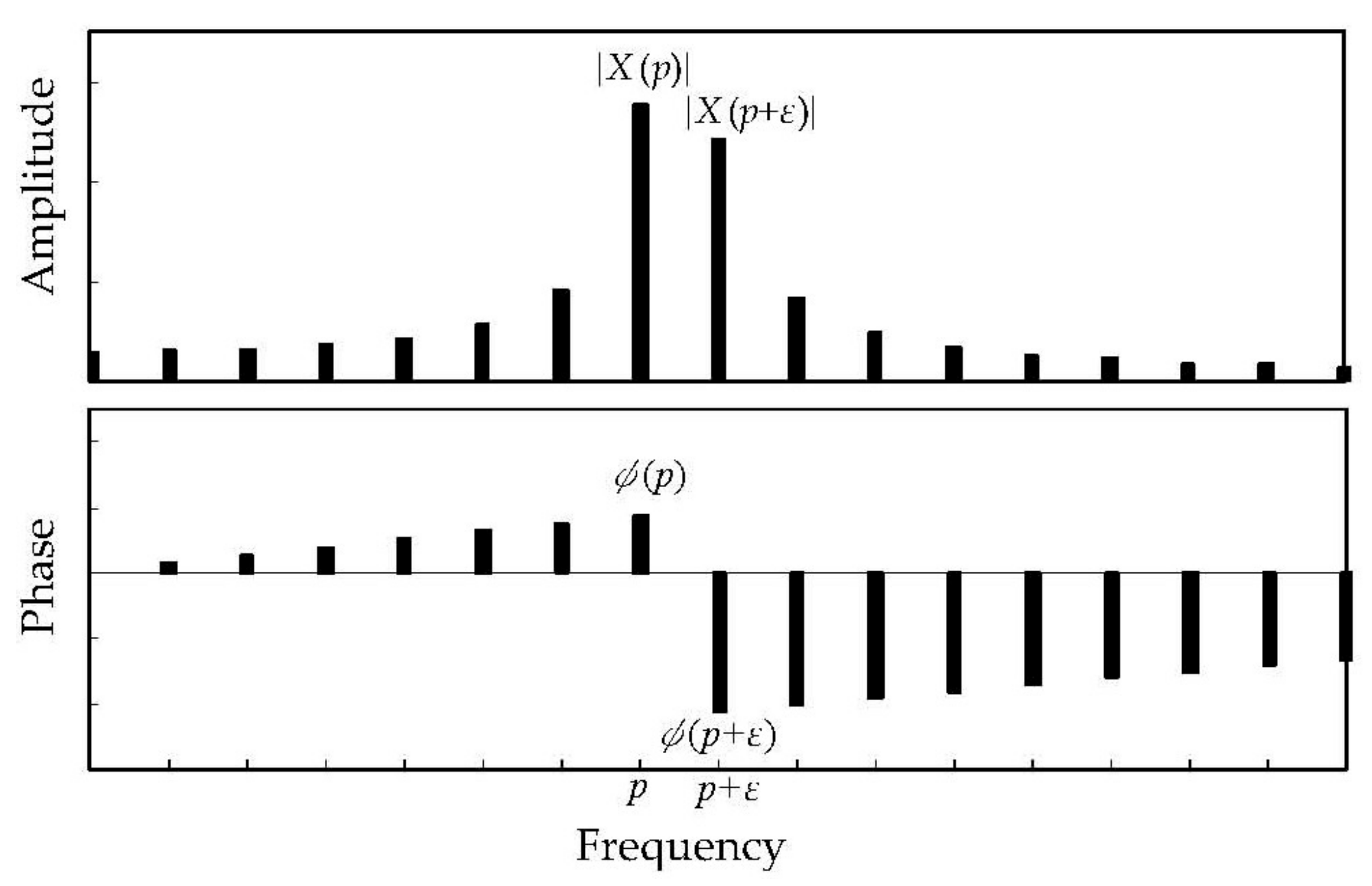

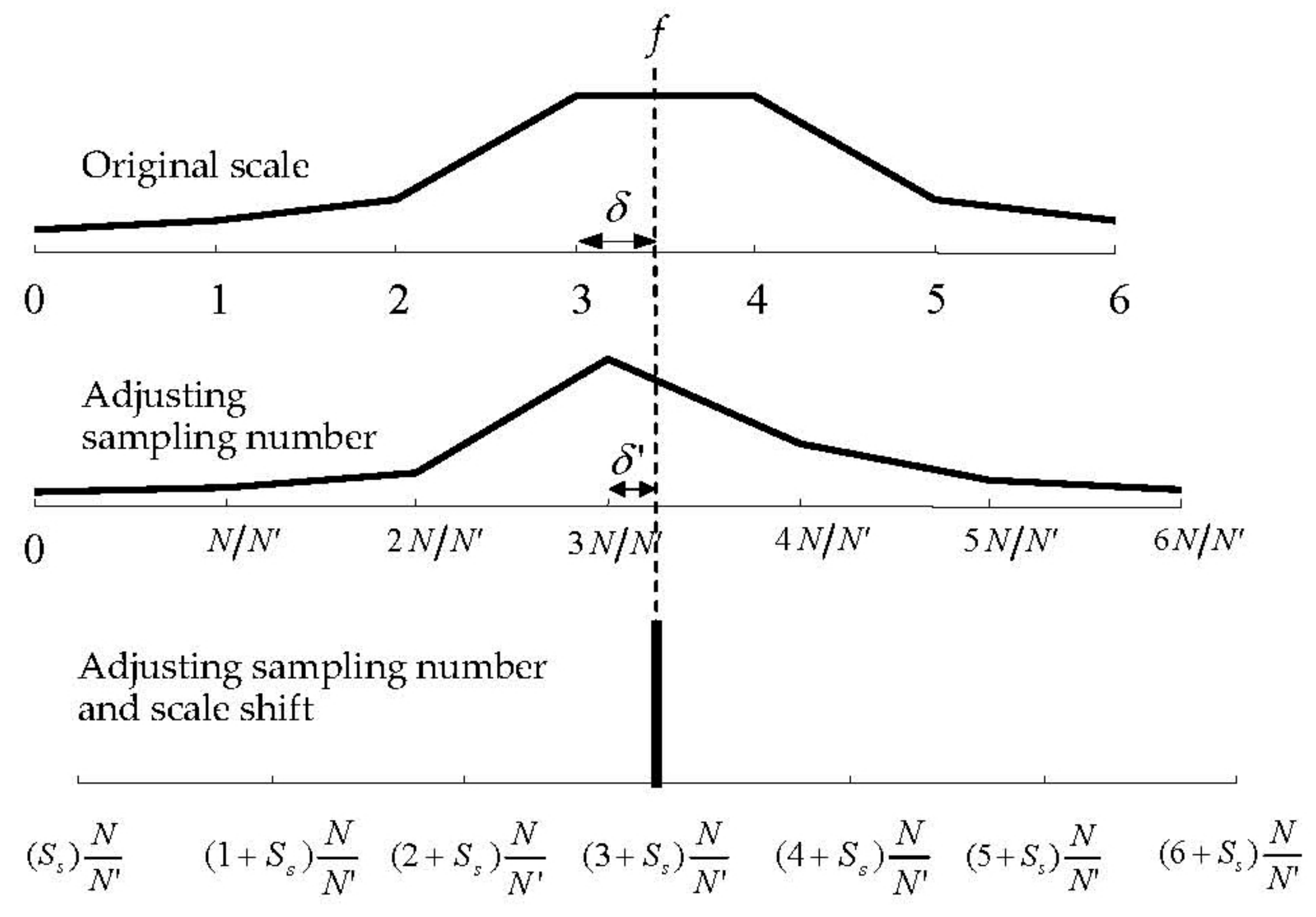
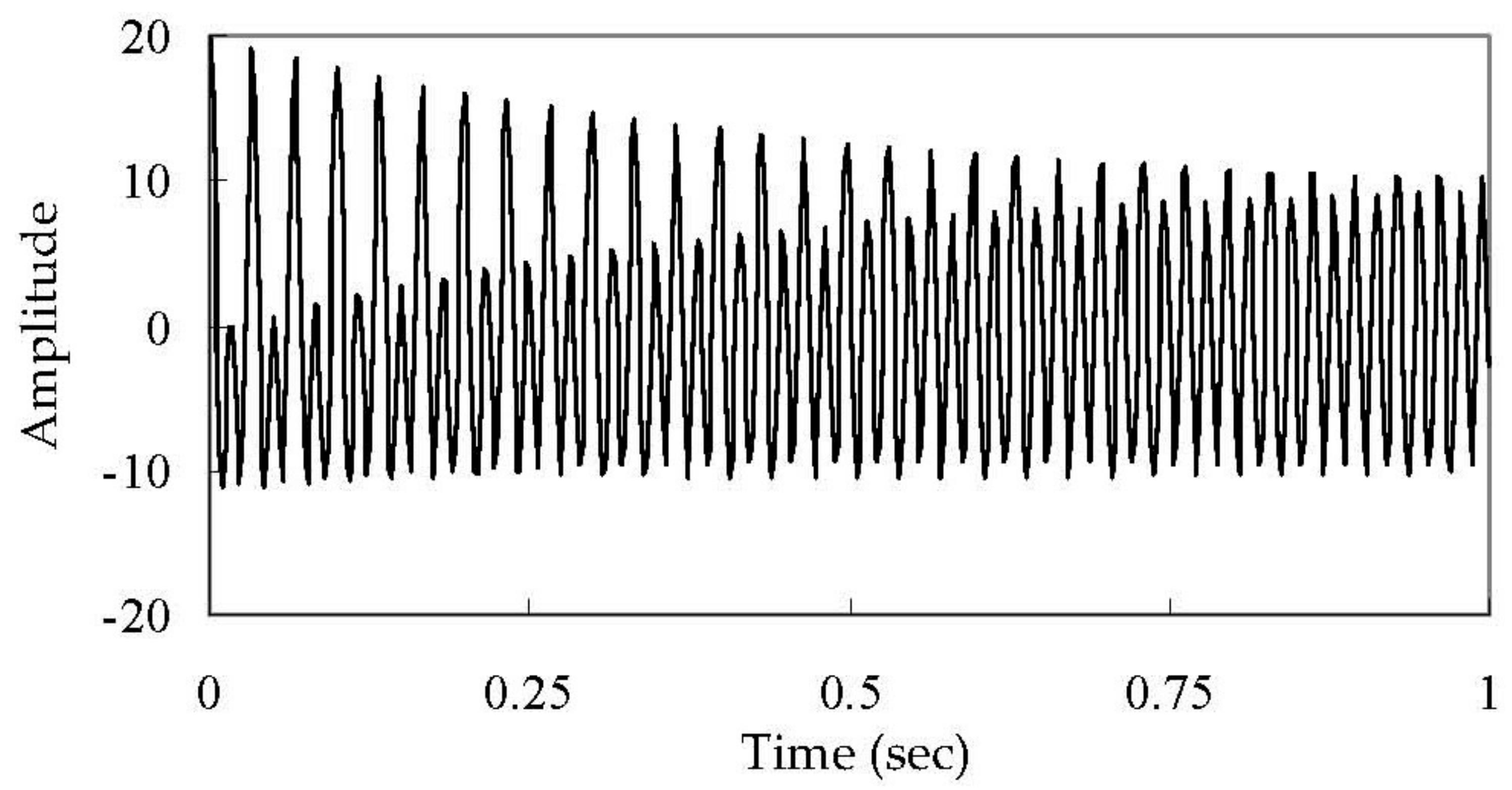
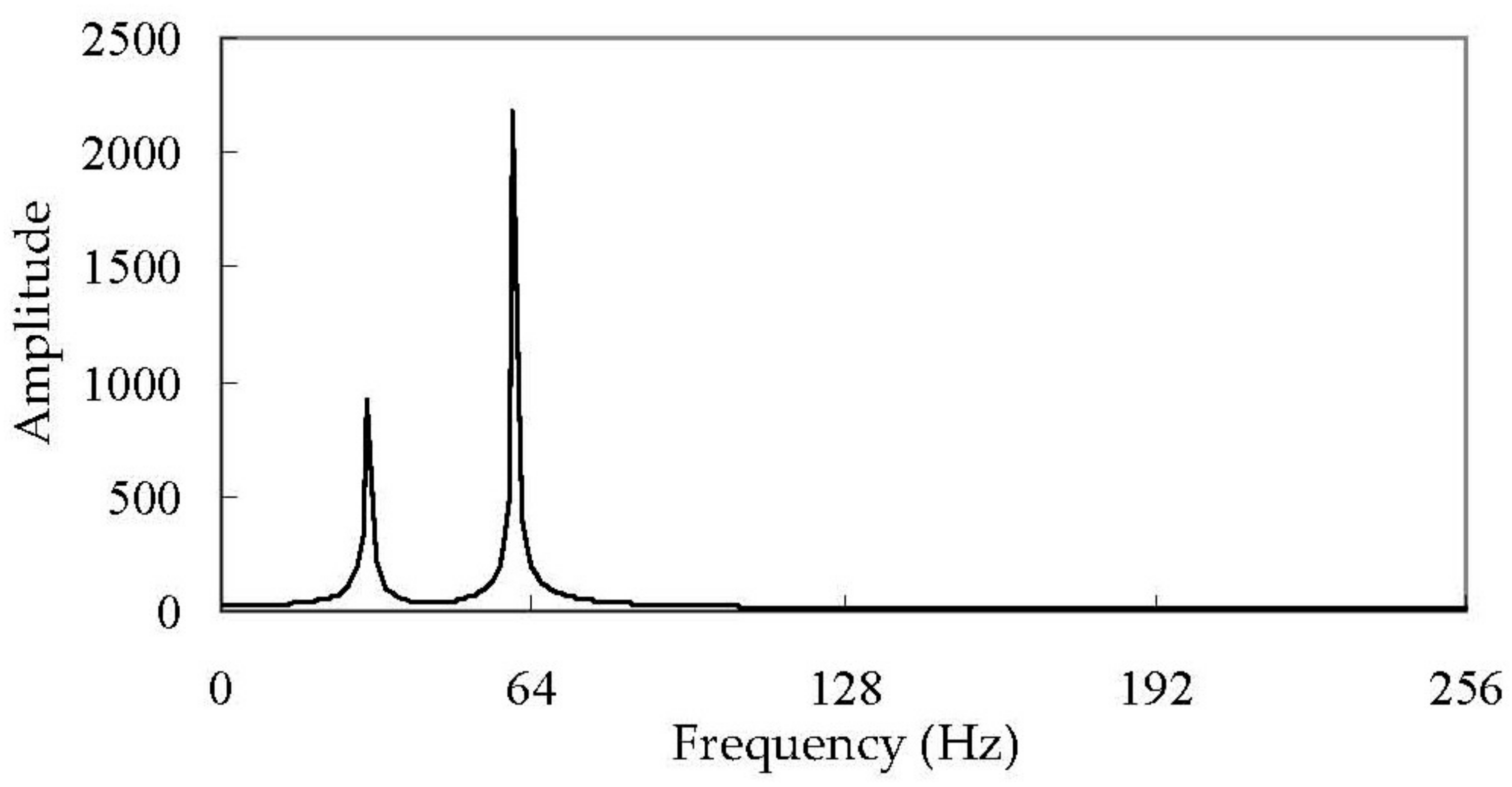
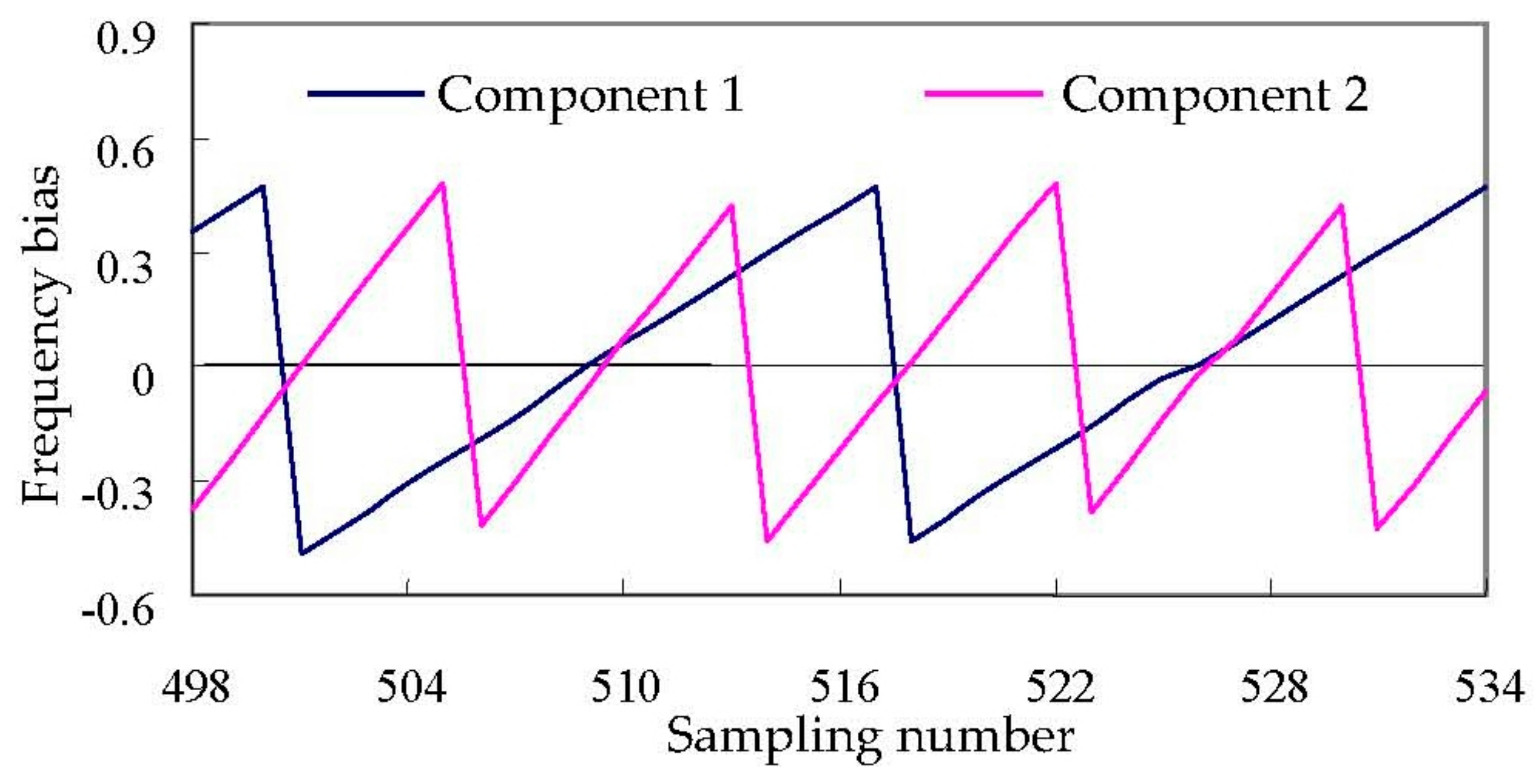
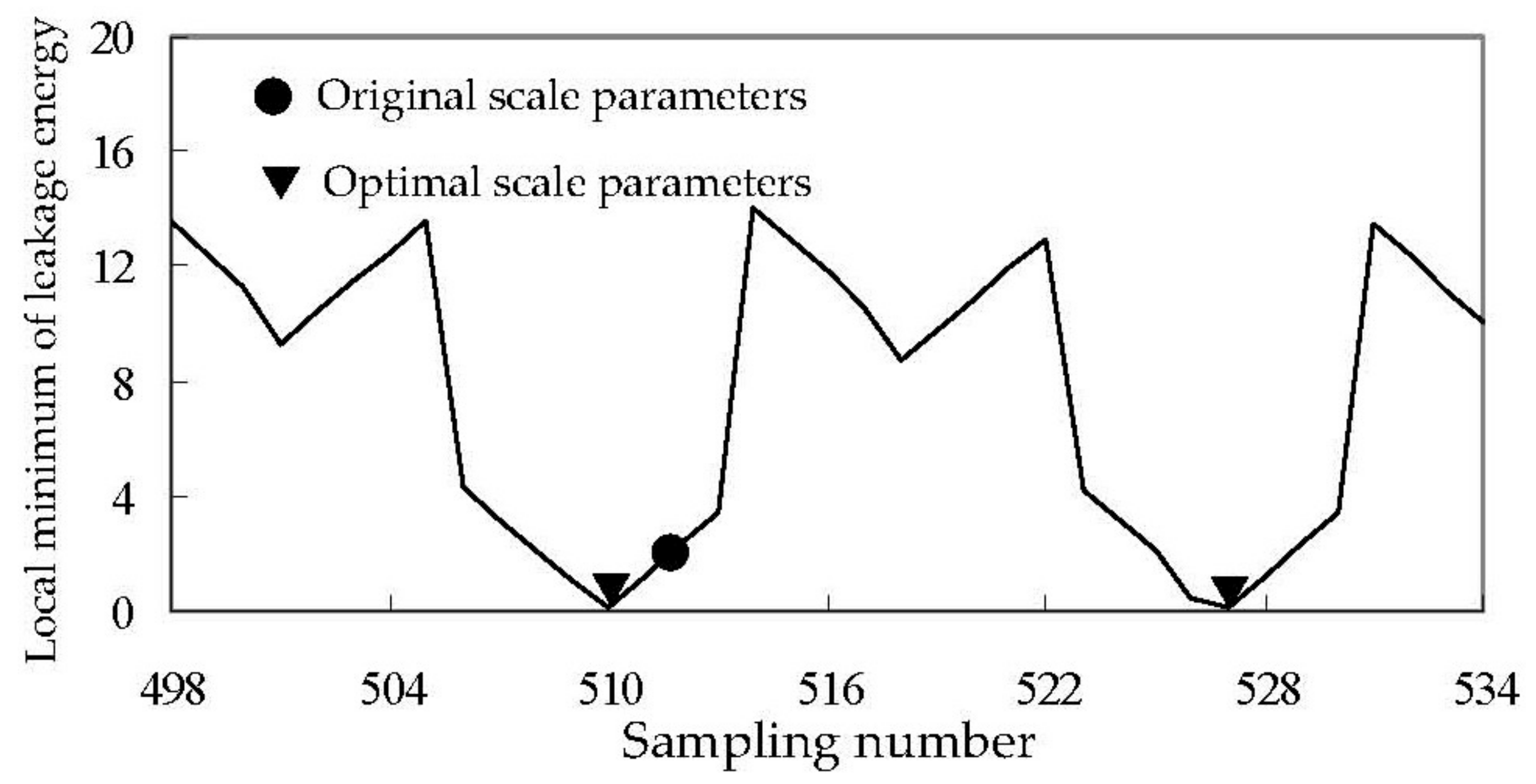
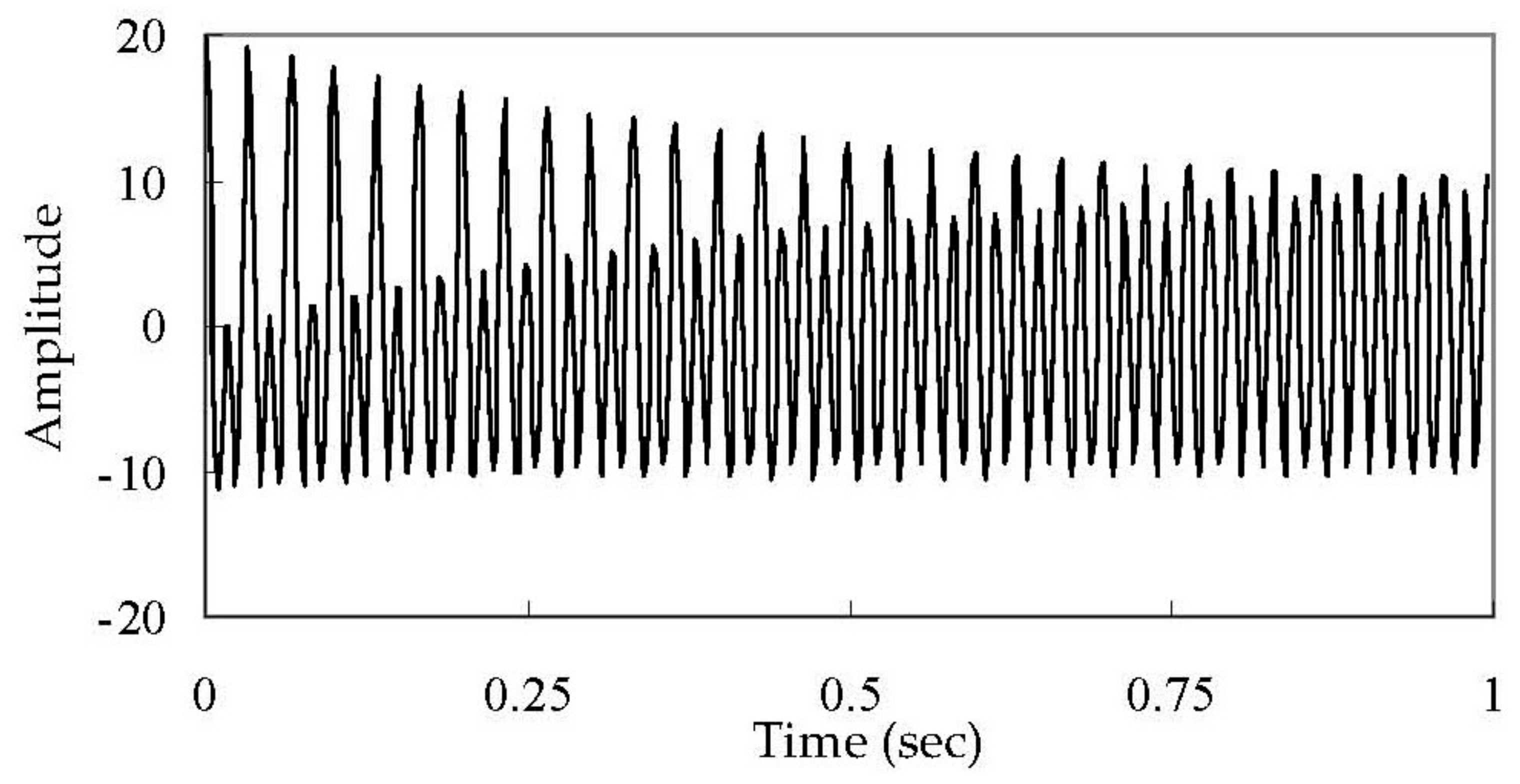
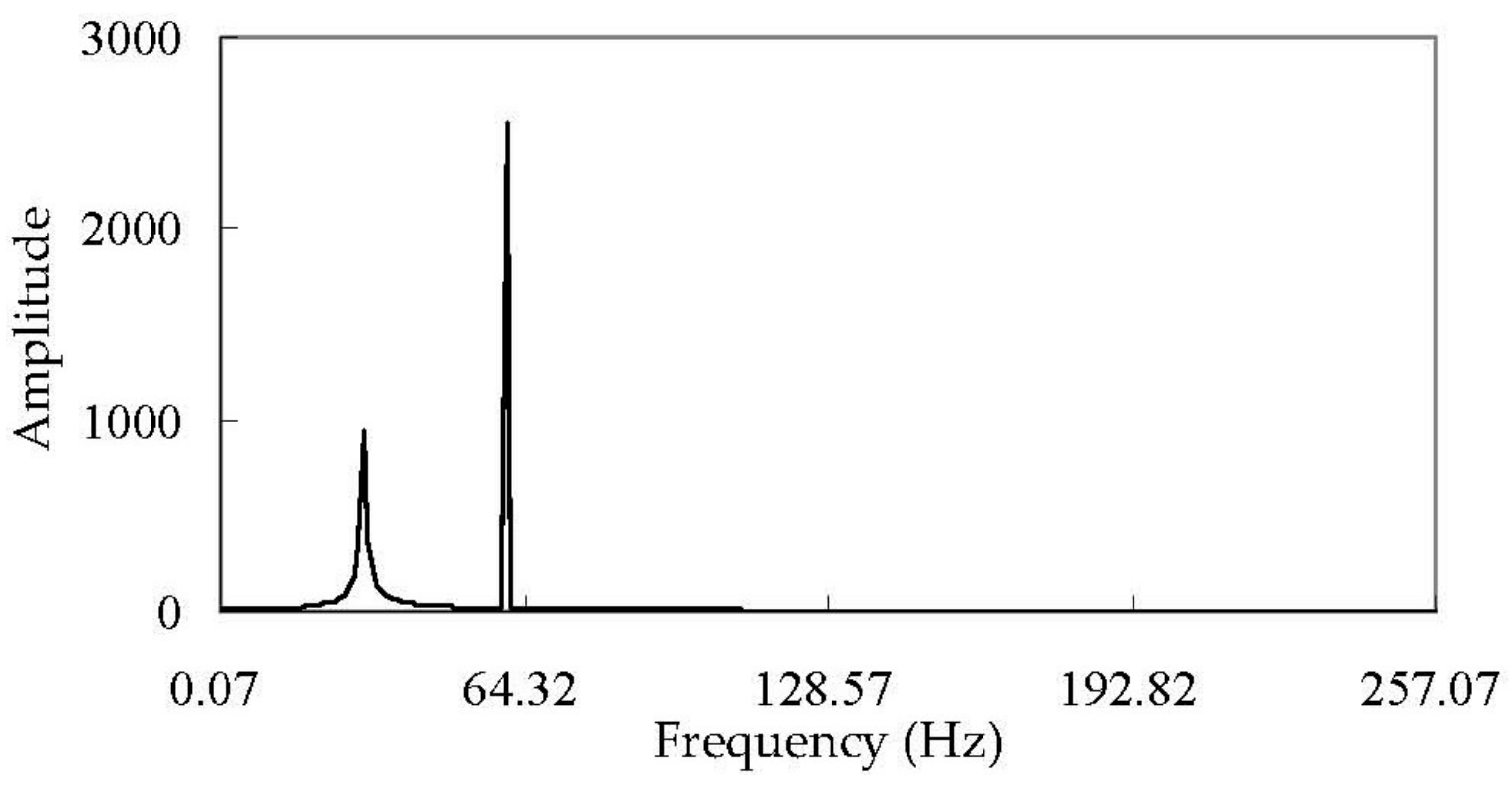
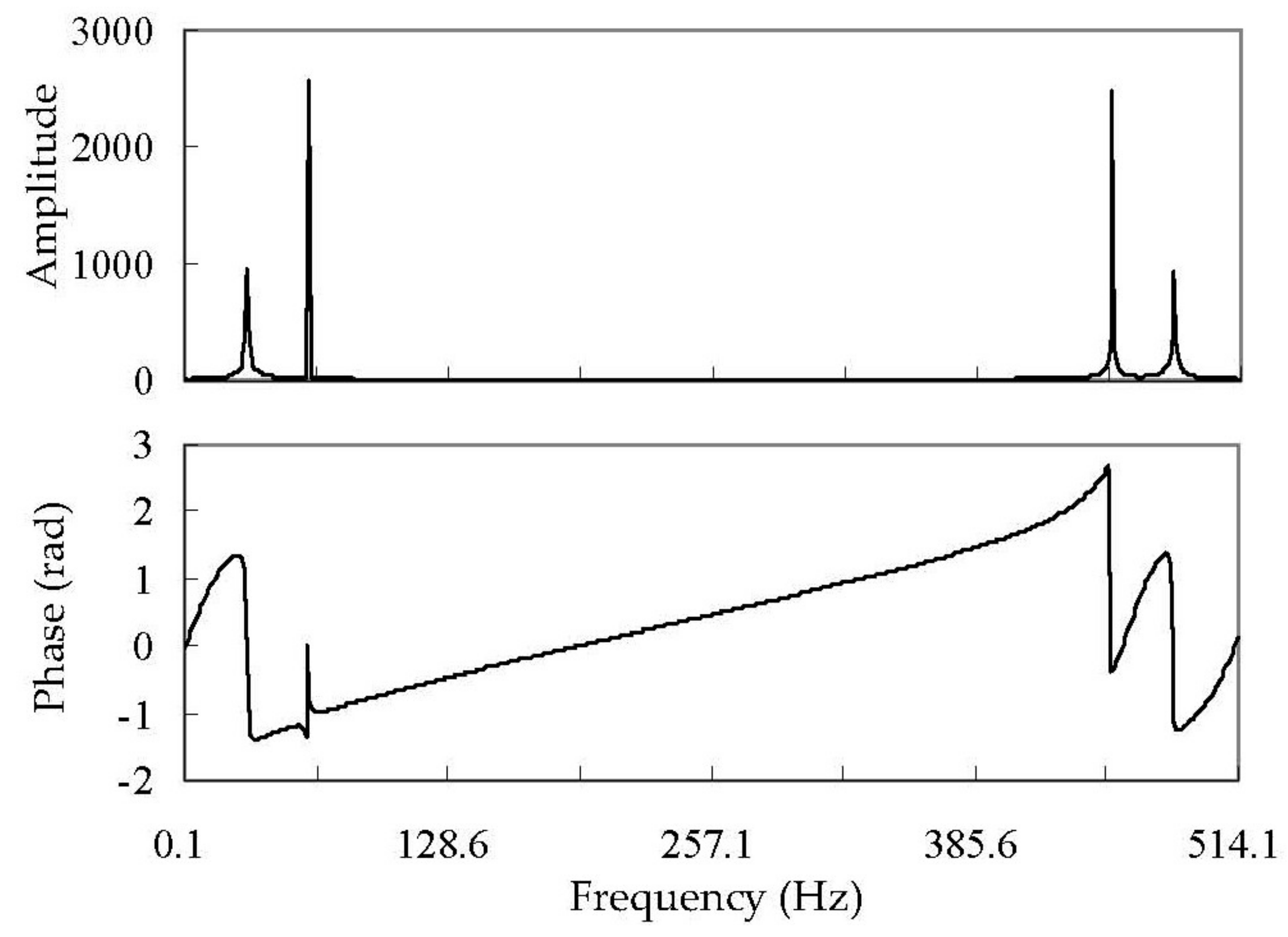
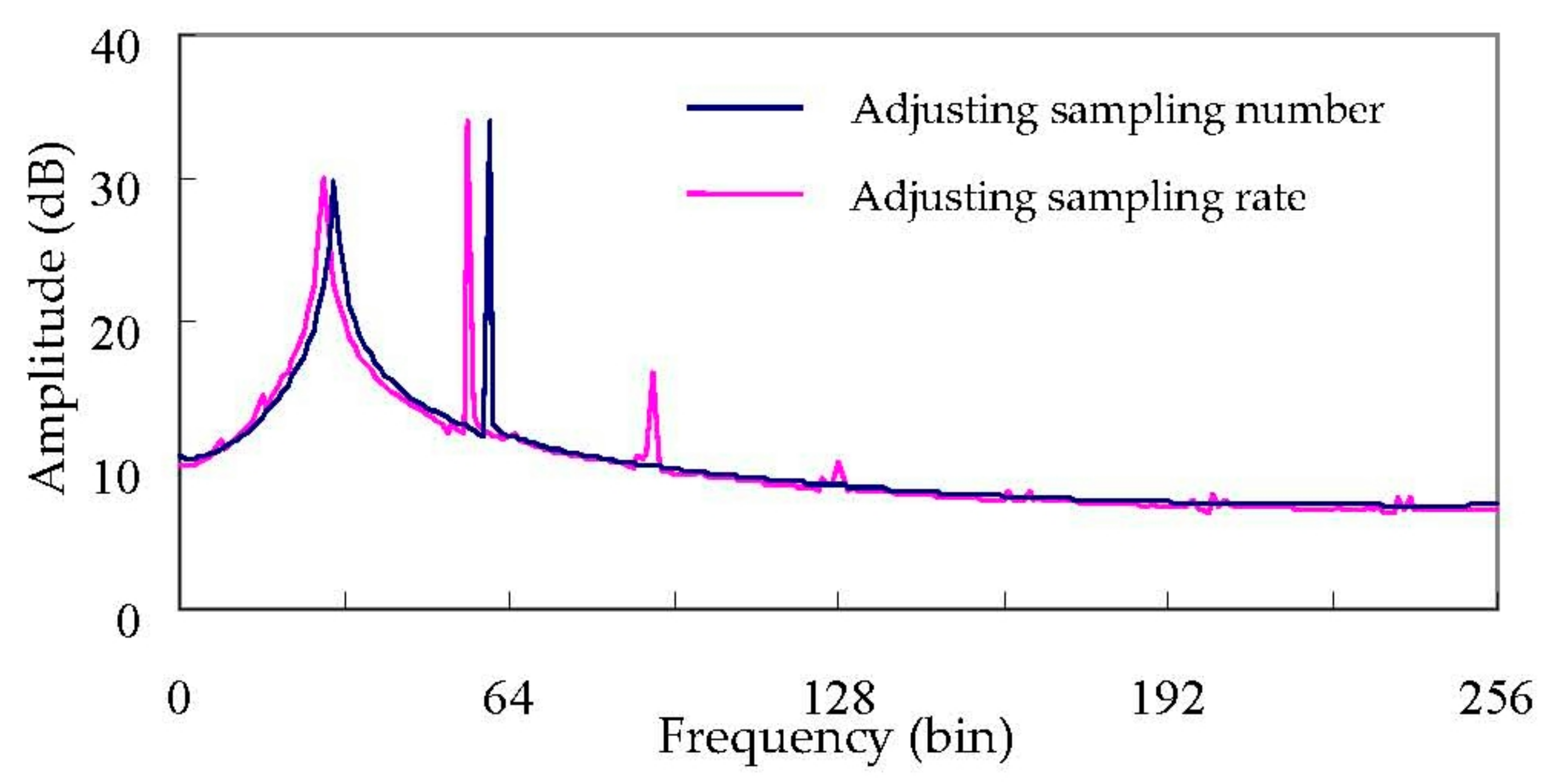

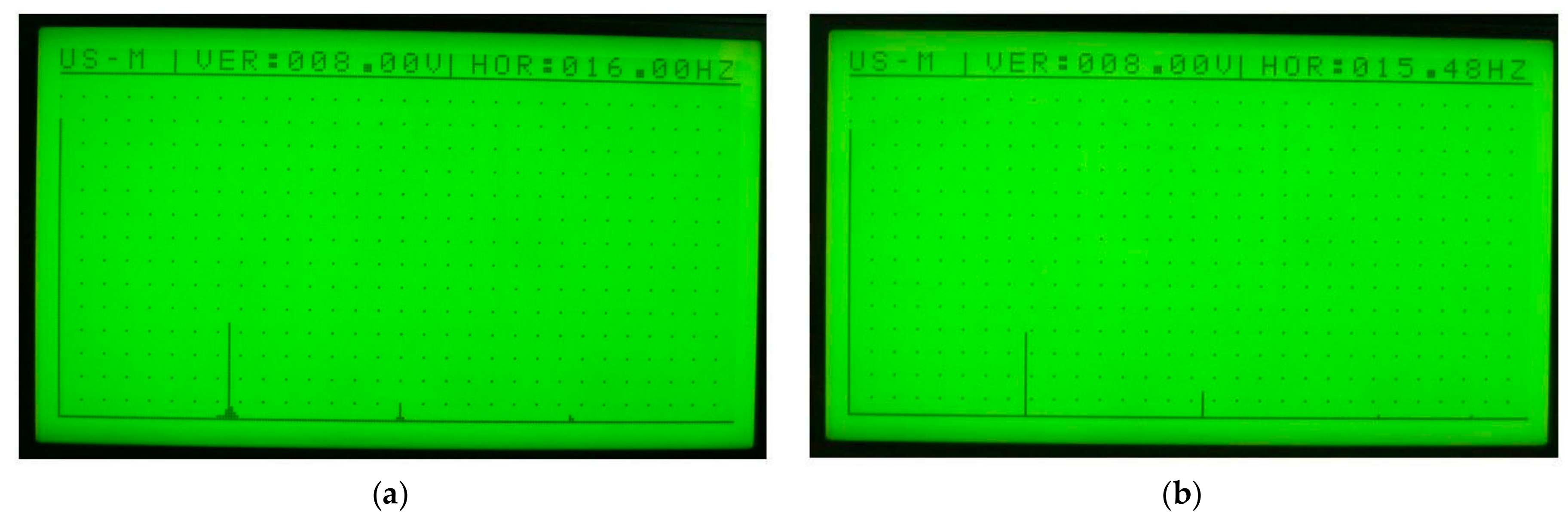
| Component | Parameter | Real Value | Analysis Result |
|---|---|---|---|
| Component 1 | Frequency | 30.2 | 30.177 |
| Damping | −2.5 | −2.59 | |
| Amplitude | 10 | 10.49 | |
| Phase | 0 | 0.044 | |
| |X’(p)| | 939.95 | 956.66 | |
| Component 2 | Frequency | 60.3 | 60.303 |
| Damping | 0 | −0.04 | |
| Amplitude | 10 | 10.062 | |
| Phase | 0 | −0.011 | |
| |X’(p)| | 2560 | 2557.09 |
| Component | Real Frequency | Result of FFT | Result of Optimal Scale Parameters (N’, Ss) | |
|---|---|---|---|---|
| (510, 0.066) | (527, 0.073) | |||
| Component 1 | 30.2 | 30 | 30.181 | 30.188 |
| Component 2 | 60.3 | 60 | 60.299 | 60.306 |
| Component | Parameter | Real Value | Result in Positive Frequency Domain | Result in Negative Frequency Domain |
|---|---|---|---|---|
| Component 1 | Frequency | 30.2 | 30.191 | −30.207 |
| Damping | 2.5 | 2.554 | 2.46 | |
| Amplitude | 10 | 10.291 | 10.088 | |
| Phase | 0 | 0.01 | 0.024 | |
| Component 2 | Frequency | 60.3 | 60.308 | −60.301 |
| Damping | 0 | 0.036 | 0.036 | |
| Amplitude | 10 | 10.032 | 9.994 | |
| Phase | 0 | −0.03 | 0.013 |
© 2018 by the authors. Licensee MDPI, Basel, Switzerland. This article is an open access article distributed under the terms and conditions of the Creative Commons Attribution (CC BY) license (http://creativecommons.org/licenses/by/4.0/).
Share and Cite
Wu, R.-C.; Huang, L.-J. Non-Distorted Optimization Spectrum Analysis. Energies 2018, 11, 1841. https://doi.org/10.3390/en11071841
Wu R-C, Huang L-J. Non-Distorted Optimization Spectrum Analysis. Energies. 2018; 11(7):1841. https://doi.org/10.3390/en11071841
Chicago/Turabian StyleWu, Rong-Ching, and Li-Ju Huang. 2018. "Non-Distorted Optimization Spectrum Analysis" Energies 11, no. 7: 1841. https://doi.org/10.3390/en11071841
APA StyleWu, R.-C., & Huang, L.-J. (2018). Non-Distorted Optimization Spectrum Analysis. Energies, 11(7), 1841. https://doi.org/10.3390/en11071841




